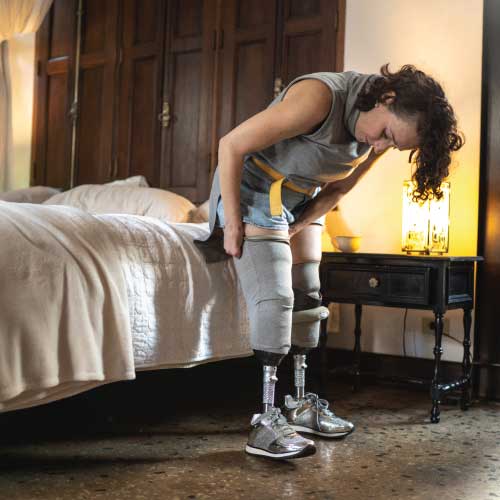Advancements in the Realm of Bionic Legs
Although prosthetic devices restore mobility to individuals who have undergone lower-limb amputation, current prosthetic technology has several limitations. Standard prosthetics cannot provide helpful feedback to the user, leading to poor mobility, a high risk of falls, and sometimes the abandonment of their prosthetic leg(s). Fortunately, researchers are developing promising technology that will soon be commercially available to address these issues.

In 2019, scientists from a European consortium, led by Swiss Institutions ETH Zurich and EPFL spin-off SensArs Neuroprosthetics, conducted a study which showed that prosthetic devices' functionality could be significantly improved by adding sensory feedback. The study's preliminary results were promising.
Three upper-leg amputees tested a bionic leg prototype with pressure sensors on the foot and an additional sensor that measures the knee angle to extract crucial sensory data from the prosthesis. When walking, the study participants' legs send different sensory information to the brain, which adjusts motion to change direction, climb stairs, or avoid obstacles. This sensory information includes touch and pressure on the foot and leg, vibration, and muscle stretch.
The researchers discovered that restoring feedback from the foot and knee improved the study participants' speed of motion, reduced the risk of falls, and improved agility. Additionally, the study participants could concentrate more effectively on an auditory task while walking when feedback was present than without it. This indicated that the prosthetic was more naturally integrated and required less continuous mental effort.
Restoring feedback from the foot and knee improved the study participants’ speed of motion, reduced the risk of falls, and improved agility.
In another experiment conducted between 2019 and 2020, amputees used the bionic leg prototype to demonstrate a deft touch on an automobile gas pedal, applying finely calibrated pressure intervals on the accelerator using feedback from the prosthetic leg.
The prosthetic leg prototype, now called SENSY, made headlines again in 2021 after SensArs Neuroprosthetics, one of the companies that tested the bionic leg’s viability in 2019, received a Breakthrough Device Designation from the US Food and Drug Administration. This would expedite SENSY’s path to commercial viability and make it the first widely available “sensing” leg.
According to Stanisa Rapopovic, one of SENSY's chief developers, the device is designed to allow intuitive contact with the residual nervous system. The sensors provide wearers with neurological feedback similar to incoming signals from a human limb, making it easier to use without extensive training.
During clinical trials, the researchers found that SENSY required far less mental energy than traditional prosthetic devices due to its direct feedback loop between the brain and the bionic limb. Additionally, because it directly stimulates the peripheral nerves in the residual limb, the SENSY tends to reduce the impact of phantom limb pain, a common issue experienced by amputees.
The impact of SENSY on the quality of life extends beyond the execution of everyday tasks. With the direct feedback loop between the brain and bionic limb, test subjects reported an improvement in awareness of their actions, which could enhance the quality of life for millions of individuals with amputations.
Currently, the company's website indicates the successful completion of human clinical trials. Additionally, the trials demonstrated pain reduction, proving the prosthetic device's safety and the restoration of natural sensations.
The FDA's Breakthrough Designation puts SENSY on a fast track to qualify for Medicare reimbursement, making it more appealing to investors and potential clinical partners.
Stay tuned for updates on the availability of SENSY.











































































